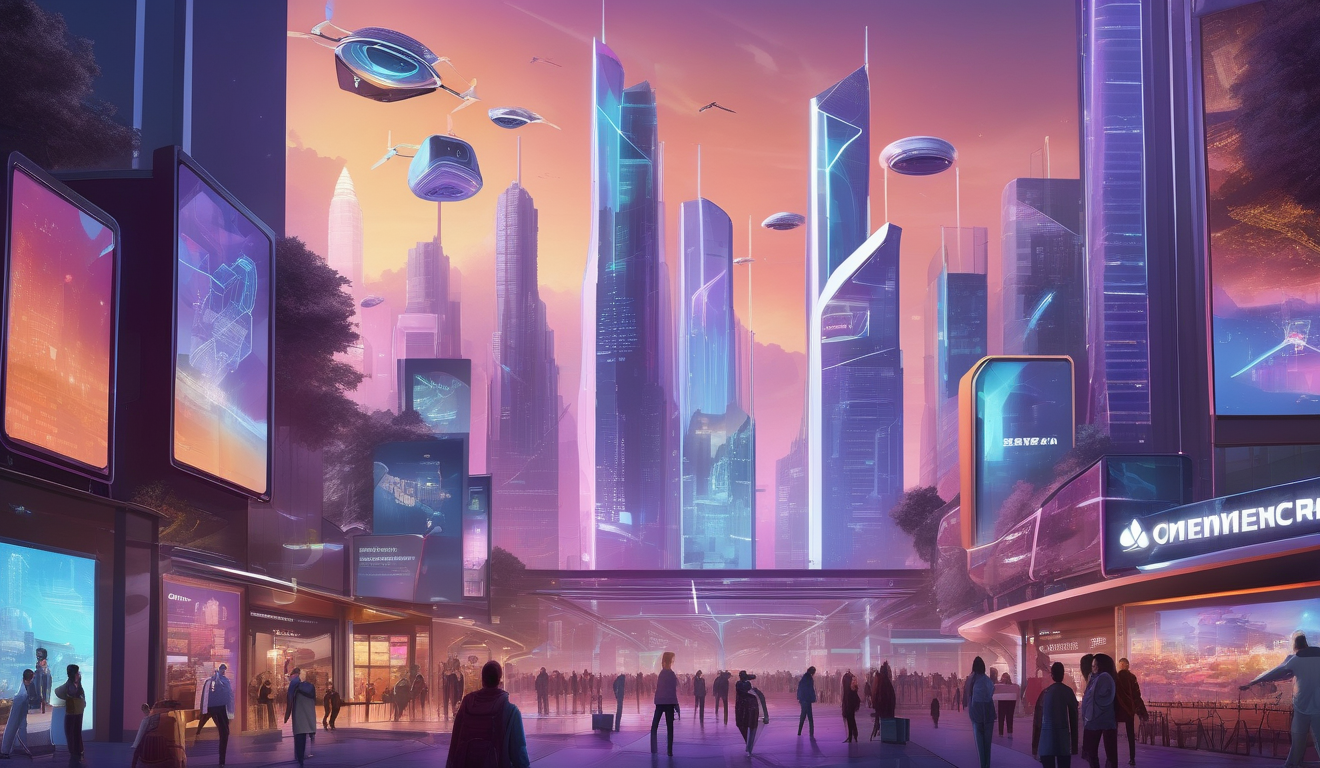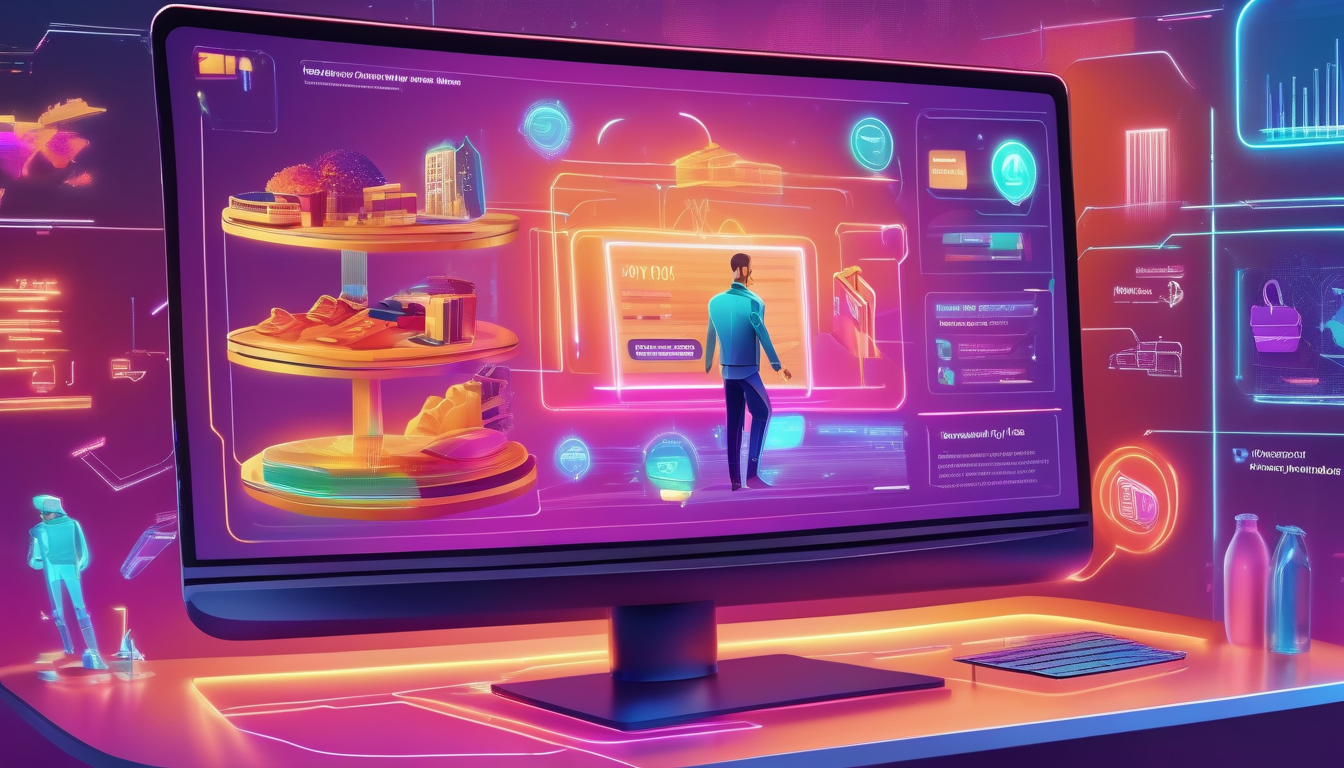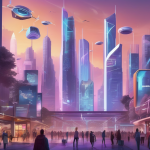The Future of E-Commerce: Trends to Watch

The world of e-commerce is evolving at an astonishing pace, and staying ahead of the curve is essential for businesses aiming to thrive in this competitive landscape. As technology advances and consumer preferences shift, several key trends are emerging that will shape the future of online shopping. From the rise of artificial intelligence to the growing importance of sustainability, these trends are not just passing fads; they represent a fundamental change in how consumers interact with brands and make purchasing decisions.
One of the most significant trends is the increasing reliance on artificial intelligence. Imagine a shopping experience where every recommendation feels tailor-made just for you. AI is making this a reality by analyzing consumer behavior and preferences to provide personalized suggestions. Chatbots are also enhancing customer service, offering instant responses to inquiries, which makes shopping smoother and more enjoyable.
Another trend to watch is the meteoric rise of mobile commerce. As smartphones become ubiquitous, more consumers are opting to shop on their mobile devices. This shift necessitates a strong focus on mobile optimization. Businesses that fail to create a seamless mobile experience risk losing potential customers. It’s like trying to navigate a maze without a map—frustrating and often leading to dead ends.
Additionally, the integration of augmented reality (AR) is revolutionizing the way we shop online. Imagine being able to see how a piece of furniture fits in your living room before making a purchase. AR is enabling customers to visualize products in their own environments, which significantly influences their buying decisions. For instance, virtual try-ons in the fashion and beauty industries allow shoppers to see how clothes or makeup look on them without ever stepping foot in a store.
Lastly, as consumers become more eco-conscious, sustainability is emerging as a critical factor in brand loyalty. E-commerce businesses are adapting by implementing sustainable practices, such as eco-friendly packaging and carbon-neutral shipping. These initiatives not only reduce environmental impact but also resonate with consumers who prioritize sustainability in their purchasing choices.
In conclusion, the future of e-commerce is bright and full of potential. By embracing these trends, businesses can create more engaging, personalized, and sustainable shopping experiences that meet the evolving needs of consumers.

Rise of Artificial Intelligence
Artificial intelligence (AI) is not just a buzzword; it’s transforming the landscape of e-commerce in ways we never thought possible. Imagine walking into a store where every item is tailored to your preferences—sounds like a dream, right? Well, AI is making that dream a reality in the digital shopping world. From personalized recommendations to smart chatbots, AI is enhancing customer experiences like never before.
One of the most exciting aspects of AI in e-commerce is its ability to analyze vast amounts of data. By leveraging predictive analytics, businesses can anticipate what customers want before they even know it themselves. This means that when you log into your favorite online store, you’re greeted with products that feel like they were handpicked just for you. It’s like having a personal shopper who knows your style and preferences inside and out!
But that’s not all. AI-powered chatbots are revolutionizing customer service. These virtual assistants can handle inquiries 24/7, providing instant responses and support. They can help with everything from tracking orders to suggesting complementary products. This level of accessibility not only improves customer satisfaction but also allows businesses to operate more efficiently. Imagine never having to wait on hold again!
Moreover, AI is also playing a crucial role in inventory management. By predicting demand trends, e-commerce platforms can optimize their stock levels, reducing waste and ensuring that popular items are always available. This is particularly important in today’s fast-paced market, where consumer preferences can shift overnight.
In summary, the rise of artificial intelligence in e-commerce is not just about technology; it’s about enhancing the customer journey. As businesses continue to adopt AI solutions, we can expect a more personalized, efficient, and enjoyable shopping experience. Are you ready to embrace the future of online shopping?

Mobile Commerce Growth
In today’s fast-paced world, mobile commerce is not just a trend; it’s a revolution that’s reshaping the way we shop. With the explosion of smartphone usage, consumers are increasingly turning to their mobile devices for everything from browsing to buying. Did you know that over 50% of all online transactions now occur on mobile devices? This shift is not merely a statistic; it’s a clear indication that businesses must adapt or risk being left behind.
The importance of mobile optimization cannot be overstated. As consumers become more accustomed to the convenience of shopping on their phones, the expectation for seamless mobile experiences grows. Websites that are not optimized for mobile can lead to frustrating experiences, resulting in lost sales. Imagine trying to navigate a clunky website on your phone – it’s enough to make anyone abandon their cart! Therefore, businesses must ensure their mobile sites are user-friendly, fast, and visually appealing.
Moreover, the way consumers shop is evolving. Traditional browsing has transformed into a more spontaneous and impulsive behavior. Shoppers are now influenced by social media, where platforms like Instagram and TikTok serve as virtual storefronts. This trend highlights the significance of integrating social commerce strategies into mobile platforms. By leveraging these channels, brands can create engaging content that drives traffic directly to their mobile sites, making it easier for consumers to purchase on the go.
To further illustrate this growth, here’s a quick overview of key factors driving mobile commerce:
- Convenience: Shopping anytime, anywhere is a major draw for consumers.
- Personalization: Mobile apps can offer tailored recommendations based on user behavior.
- Payment Innovations: Mobile wallets and one-click payments simplify the checkout process.
As we look to the future, businesses that prioritize mobile commerce will not only enhance their customer experience but also position themselves for success in an increasingly competitive market. The question is, are you ready to embrace this mobile-first approach?
Augmented Reality Integration
Imagine walking through your living room, holding your smartphone, and suddenly being able to see how that new couch would look in your space without moving a muscle. Augmented reality (AR) is making this dream a reality, revolutionizing the way we shop online. By merging digital information with the real world, AR is enhancing the online shopping experience and allowing customers to visualize products in their own environments before making a purchase.
One of the most exciting aspects of AR integration in e-commerce is its ability to influence consumer decision-making. Shoppers can interact with products in a way that feels tangible, which significantly reduces the uncertainty often associated with online purchases. For instance, a customer can use an AR app to see how a piece of furniture fits into their home, ensuring that it matches their style and space. This immersive experience not only boosts confidence in purchasing decisions but also leads to higher customer satisfaction rates.
Here are some key benefits of AR in e-commerce:
- Enhanced Engagement: AR applications captivate users, making the shopping experience more interactive and enjoyable.
- Reduced Returns: By allowing customers to visualize products in their own environment, AR helps minimize the chances of returns due to mismatched expectations.
- Increased Sales: Engaging AR experiences can lead to higher conversion rates, as customers are more likely to complete a purchase when they can see the product in action.
In the fashion industry, for example, AR is being utilized with virtual try-ons, allowing customers to see how clothing or accessories look on them without ever stepping into a store. This technology not only saves time but also creates a unique shopping experience that resonates with the modern consumer’s desire for convenience and personalization.
As AR technology continues to evolve, it will undoubtedly play a crucial role in shaping the future of e-commerce. Businesses that embrace this innovation will not only enhance their customer experience but also gain a competitive edge in an increasingly crowded market. So, next time you’re shopping online, keep an eye out for those AR features—they might just change the way you shop forever!
Virtual Try-Ons
Imagine stepping into a world where trying on clothes or makeup is as easy as a click of a button—welcome to the era of . This revolutionary technology is transforming how consumers shop online, particularly in the fashion and beauty industries. With the help of augmented reality (AR), shoppers can now see how products look on them without ever leaving their homes. Isn’t that amazing?
Virtual try-ons leverage sophisticated algorithms and AR technology to create a seamless shopping experience. For instance, when you’re browsing a clothing website, you can use your smartphone or computer camera to project an outfit onto your own image. This not only saves time but also reduces the uncertainty that often comes with online shopping. Consumers no longer have to worry about fit or style; they can visualize the product in real-time, making informed decisions.
But how exactly does this technology work? It uses a combination of 3D modeling and computer vision to map your body and overlay digital items onto it. The result? A hyper-realistic representation of how that dress or pair of shoes will look on you. This level of interactivity is changing the game, making online shopping more engaging and enjoyable.
Moreover, brands are increasingly adopting virtual try-on solutions to boost their sales. According to recent studies, customers who use virtual try-ons are over 60% more likely to complete a purchase. This statistic underscores the importance of integrating such technologies into e-commerce strategies. Companies that embrace virtual try-ons not only enhance customer satisfaction but also gain a competitive edge in a crowded market.
In conclusion, virtual try-ons are not just a passing trend; they represent the future of online shopping. As technology continues to evolve, we can expect even more innovative features that will make shopping an immersive experience. So, the next time you’re about to buy that stunning outfit or the latest lipstick, remember that you can see it on yourself first—thanks to virtual try-ons!
Home Decor Visualization
Imagine being able to see how that stunning new sofa or chic coffee table would look in your living room before you even make a purchase. is making this dream a reality, thanks to the power of augmented reality (AR). This innovative technology allows customers to superimpose virtual furniture and decor items into their own spaces using just their smartphones or tablets. Not only does this enhance the shopping experience, but it also significantly influences purchasing decisions.
With AR, consumers can experiment with different styles, colors, and arrangements without the hassle of moving heavy furniture or worrying about returns. This technology acts as a personal interior designer, providing users with a realistic preview of how products will fit and look in their homes. It’s like having a magic window into your future space! As shoppers become more comfortable with visualizing products in their environments, they are more likely to make informed decisions, reducing the chances of buyer’s remorse.
The impact of home decor visualization extends beyond individual purchases; it also shapes brand loyalty. When customers have a positive experience using AR, they are more inclined to return to the brand for future purchases. This creates a cycle of engagement that benefits both the consumer and the retailer. Companies that invest in AR technology not only attract tech-savvy customers but also position themselves as forward-thinking leaders in the competitive e-commerce landscape.
To give you a clearer picture of how AR is transforming home decor shopping, consider the following benefits:
- Increased Engagement: Shoppers spend more time interacting with AR features, leading to higher conversion rates.
- Reduced Returns: By visualizing products in their own space, customers are less likely to return items that don’t meet their expectations.
- Enhanced Creativity: AR encourages customers to experiment with different styles and arrangements, making the shopping experience more enjoyable.
In conclusion, home decor visualization through augmented reality is not just a trend; it’s a game-changer in the e-commerce world. As technology continues to evolve, we can expect even more innovative solutions that will make shopping for home decor an exciting and seamless experience.
Subscription Services Expansion
Subscription services are not just a trend; they are rapidly becoming a necessity for many consumers in today’s fast-paced world. Imagine waking up and having your favorite products delivered right to your doorstep without even lifting a finger! This convenience is what modern shoppers crave, and businesses are responding accordingly. The appeal of subscription models lies in their ability to offer personalized experiences that cater to individual needs and preferences.
As we delve deeper into this phenomenon, it’s clear that several factors are driving the expansion of subscription services:
- Convenience: With busy lifestyles, consumers are turning to subscriptions for everything from meal kits to beauty products, saving them time and effort.
- Cost-Effectiveness: Many subscription services offer discounts compared to one-time purchases, making them more appealing to budget-conscious shoppers.
- Personalization: Brands are leveraging data analytics to tailor their offerings, ensuring that customers receive products that genuinely meet their needs.
These factors are reshaping how businesses approach their marketing strategies. For instance, companies like Dollar Shave Club and Birchbox have built their success on providing unique and personalized subscription experiences. They have not only captured market share but also fostered strong customer loyalty through their innovative approaches.
Moreover, the subscription model is evolving. Businesses are experimenting with various types of subscriptions, including:
| Type of Subscription | Description |
|---|---|
| Curated Boxes | Monthly selections of products based on user preferences. |
| Service Subscriptions | Access to exclusive content or services, such as streaming platforms. |
| Auto-Replenishment | Automatic delivery of essential items at regular intervals. |
As the landscape of e-commerce continues to evolve, businesses that embrace the subscription model stand to gain a competitive edge. By focusing on customer satisfaction and adapting to changing consumer needs, they can create lasting relationships that go beyond a single transaction. In a world where convenience is king, subscription services are paving the way for a future where shopping is not just a chore, but a delightful experience.

Sustainability in E-Commerce
In today’s world, sustainability is not just a buzzword; it’s a crucial factor influencing consumer choices. As environmental concerns rise, shoppers are increasingly opting for brands that prioritize eco-friendly practices. This shift is reshaping the e-commerce landscape, compelling businesses to innovate and adapt. Companies that embrace sustainability are not only meeting customer expectations but also standing out in a crowded market.
Many consumers are now making purchasing decisions based on a brand’s environmental impact. Research shows that over 70% of consumers are willing to pay more for sustainable products. This statistic highlights a significant opportunity for e-commerce businesses to align their practices with the values of their target audience. But what does sustainability look like in the realm of e-commerce?
One of the most impactful areas is eco-friendly packaging. Traditional packaging materials contribute significantly to waste, but innovative companies are exploring alternatives. For instance, brands are now using biodegradable, recyclable, or reusable materials to minimize their environmental footprint. This shift not only appeals to eco-conscious consumers but also enhances brand loyalty.
Another vital aspect of sustainability in e-commerce is carbon neutral shipping. As online shopping continues to grow, so does the carbon footprint associated with shipping. Many brands are taking steps to offset their emissions by investing in renewable energy projects or planting trees. By promoting carbon-neutral shipping options, companies can attract environmentally aware customers who prioritize responsible delivery methods.
To illustrate the impact of sustainability in e-commerce, consider the following table:
| Practice | Impact on Consumers |
|---|---|
| Eco-Friendly Packaging | Increases brand loyalty and attracts eco-conscious buyers |
| Carbon Neutral Shipping | Enhances brand image and appeals to environmentally aware shoppers |
| Sustainable Sourcing | Builds trust and encourages repeat purchases |
In conclusion, sustainability is no longer optional for e-commerce businesses. It’s a strategic imperative that can drive growth and foster customer loyalty. By adopting sustainable practices, companies not only contribute to a healthier planet but also position themselves as leaders in a rapidly evolving market.
Eco-Friendly Packaging
In today’s world, sustainability has become a buzzword, especially in the realm of e-commerce. Consumers are increasingly aware of their choices and are leaning towards brands that prioritize the planet. One of the most impactful ways businesses can demonstrate their commitment to sustainability is through . This isn’t just a trend; it’s becoming a necessity as shoppers demand more environmentally responsible options.
Eco-friendly packaging encompasses a variety of materials and methods designed to minimize environmental impact. Companies are shifting away from traditional plastics and opting for biodegradable, recyclable, or reusable materials. This transition not only helps reduce waste but also resonates with eco-conscious consumers who are willing to support brands that align with their values. For instance, many businesses are now using materials like recycled paper, plant-based plastics, and even mushroom-based packaging that decompose naturally.
Moreover, the design of packaging plays a crucial role in sustainability. Brands are rethinking their packaging strategies to ensure that they are not only functional but also environmentally friendly. This includes reducing excess packaging, using minimalistic designs, and ensuring that every element can be recycled. A study indicated that over 70% of consumers prefer brands that use sustainable packaging, highlighting its importance in purchasing decisions.
To illustrate the growing trend, consider the following table that showcases some popular eco-friendly packaging materials:
| Material | Benefits |
|---|---|
| Recycled Paper | Biodegradable and recyclable, reduces deforestation. |
| Plant-Based Plastics | Made from renewable resources, compostable under industrial conditions. |
| Mushroom Packaging | Completely biodegradable, grown from agricultural waste. |
In conclusion, adopting eco-friendly packaging is not just about compliance; it’s about building a brand identity that resonates with modern consumers. As e-commerce continues to evolve, businesses that prioritize sustainability will not only enhance their reputation but also foster customer loyalty. The shift towards eco-friendly practices is not just an option; it’s a vital step towards a sustainable future.
Carbon Neutral Shipping
As environmental concerns continue to rise, has emerged as a vital strategy for e-commerce brands looking to differentiate themselves in a crowded marketplace. But what does it really mean to be carbon neutral? Essentially, it involves balancing out the carbon emissions produced during the shipping process by investing in projects that reduce or capture an equivalent amount of carbon from the atmosphere. This can include reforestation initiatives, renewable energy projects, or carbon capture technologies.
Many consumers today are not just looking for great products; they want to support brands that align with their values. In fact, studies have shown that a significant percentage of shoppers are willing to pay more for sustainable options. This shift in consumer behavior is prompting e-commerce businesses to rethink their logistics and delivery models. By adopting carbon neutral shipping practices, companies can appeal to eco-conscious customers and enhance their brand loyalty.
Implementing carbon neutral shipping involves several key steps:
- Assessing Emissions: The first step is to calculate the carbon footprint of the shipping process. This includes emissions from transportation, packaging, and warehousing.
- Reducing Emissions: Companies should look for ways to minimize their carbon output through more efficient transportation methods, optimizing delivery routes, and using sustainable packaging materials.
- Offsetting Remaining Emissions: For emissions that cannot be eliminated, businesses can invest in verified carbon offset projects. This not only compensates for their emissions but also contributes to global sustainability efforts.
Moreover, some companies are making their commitment to sustainability more visible. For instance, they might include a carbon calculator on their websites, allowing customers to see the environmental impact of their purchases. This transparency can foster trust and encourage more consumers to choose eco-friendly options.
As the e-commerce landscape evolves, the emphasis on sustainability and carbon neutral shipping will only grow stronger. Brands that take proactive steps to implement these practices will not only contribute to a healthier planet but also position themselves as leaders in a market that increasingly values environmental responsibility.
Frequently Asked Questions
- What role does artificial intelligence play in e-commerce?
Artificial intelligence is revolutionizing e-commerce by offering personalized shopping experiences. From chatbots that assist customers in real-time to algorithms that suggest products based on previous purchases, AI makes online shopping smoother and more efficient.
- Why is mobile commerce becoming increasingly important?
With more consumers using smartphones for shopping, mobile commerce is booming. Businesses need to optimize their websites for mobile use to capture this audience, as mobile shopping offers convenience and flexibility that traditional shopping can’t match.
- How does augmented reality enhance the shopping experience?
Augmented reality allows customers to visualize products in their own space before making a purchase. Whether it’s seeing how a piece of furniture fits in their living room or trying on clothes virtually, AR helps consumers make informed decisions, reducing the chances of returns.
- What are the benefits of subscription services in e-commerce?
Subscription services provide convenience and tailored experiences for consumers. They allow customers to receive products regularly without the hassle of reordering, making shopping easier and often more cost-effective.
- How are e-commerce brands becoming more sustainable?
Many e-commerce businesses are adopting sustainable practices by using eco-friendly packaging and offering carbon-neutral shipping options. This shift is driven by consumer demand for environmentally responsible brands, helping to reduce the overall ecological footprint of online shopping.
- What are eco-friendly packaging options?
Eco-friendly packaging includes materials that are biodegradable, recyclable, or made from sustainable sources. Brands are increasingly using these options to meet consumer expectations and reduce waste, making their products more appealing to eco-conscious shoppers.













